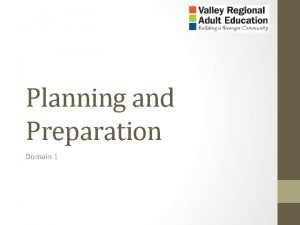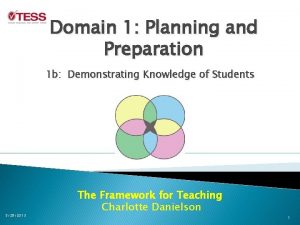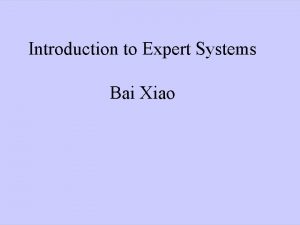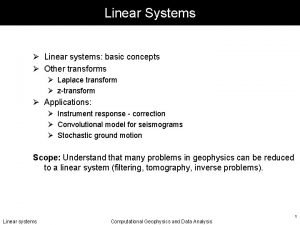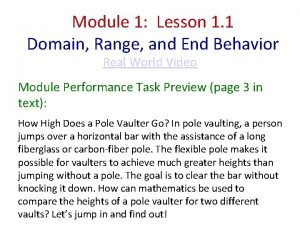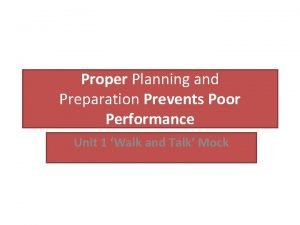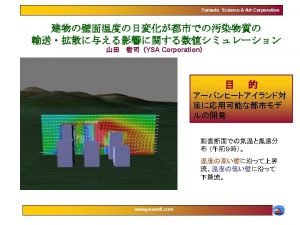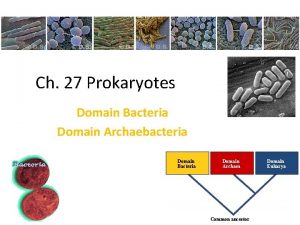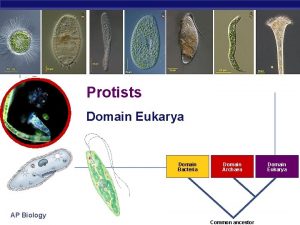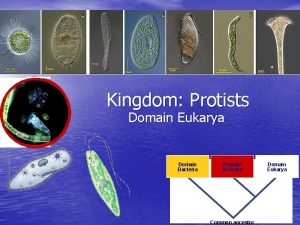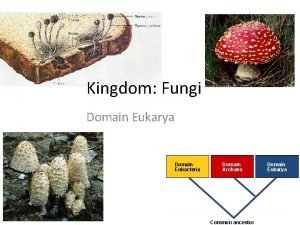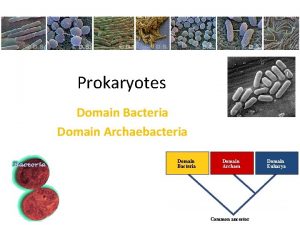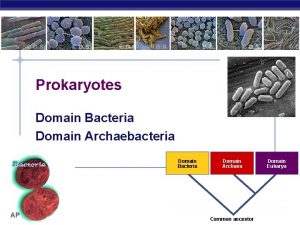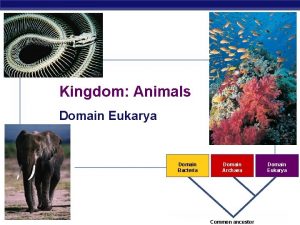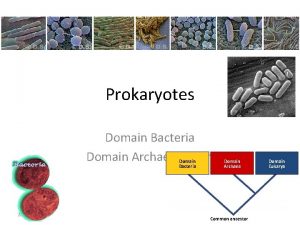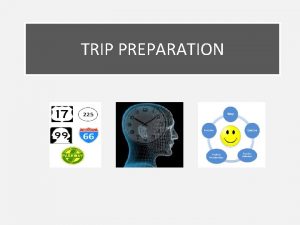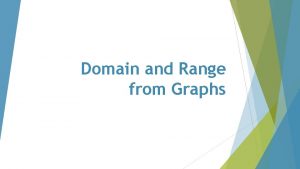Lesson Planning and Preparation Domain 1 Planning Preparation


















- Slides: 18

Lesson Planning and Preparation Domain #1: Planning, Preparation & Assessment

Consider the factors that affect student learning. Social, economic, family environment, school environment, the teacher, class size, available materials and resources, technology…. the list goes on and on. Which factor, according to the research, has the greatest impact? © 2009 Mc. Kay Consulting, LLC 2

Teaching Makes the Difference “The most important factor affecting student learning is the teacher…. . an influence many times greater than poverty or perpupil expenditures. ” “The effect of increases in teacher quality swamps the impact of any other educational investment, such as reductions in class size. ” Goldhaber, 2009 Sanders, Wright and Horn 1997 © 2009 Mc. Kay Consulting, LLC 3

Regents Reform Agenda

Purpose of Our Work Today Domain #1: Planning, Preparation & Assessment

A Road Map…. Because teaching is complex, it is helpful to have a road map through the territory, structured around a shared understanding of teaching. Charlotte Danielson © 2009 Mc. Kay Consulting, LLC 6

A Framework for Teaching: Professional Practice Rubric Domain 1: Planning and Preparation a. Demonstrating knowledge of content and pedagogy b. Demonstrating knowledge of students c. Setting instructional outcomes d. Demonstrating knowledge of resources e. Designing coherent instruction f. Designing student assessments Domain 2: The Classroom Environment a. Creating an environment of respect and rapport b. Establishing a culture for learning c. Managing classroom procedures d. Managing student behavior e. Organizing physical space Domain 4: Professional Responsibilities a. Reflecting on teaching b. Maintaining accurate records c. Communicating with families d. Participating in a professional Community e. Growing and developing professionally f. Demonstrating professionalism Domain 3: Instruction a. Communicating with students b. Using questioning and discussion techniques c. Engaging students in learning d. Using assessment in instruction e. Demonstrating flexibility and responsiveness © 2009 Mc. Kay Consulting, LLC Danielson 2007 7

Lesson Planning and Preparation The greater the structure of a lesson and the more precise the directions on what is to be accomplished, the higher the achievement rate. Harry Wong, The First Days of Teaching

Consider This Research … • According to Emma Mc. Donald, co-author of Survival Tips for New Teachers (2006), “One of the best ways to lower the amount of stress you deal with on a daily basis is to be prepared. ” She adds, “Preparation is absolutely the key to being a successful teacher. The more thought and effort you put into your lessons and your job, the better you will be. You also will be less stressed during the year. ” • Teachers are not the only ones to benefit greatly from effective lesson planning. Research indicates that all students benefit from, and appreciate, wellstructured lessons. (Kizlik, 2010). • Students are very observant. They generally know when teachers are prepared. Students today seem to have a need for constant momentum or stimulation (Marcotte, 2010). When there is “down time”, or hesitation from teachers trying to decide what to do, students can shift quickly from being on-track to off and away from the task at hand. Teachers who have planned well for a lesson are more likely to have attentive students. An atmosphere that helps them be more attentive is a definite benefit to students from effectively planned lessons. Our Students Are Depending on Us!

The Advantages G O O D F I R S T T E A C H I N G • • Increased Student Performance Clear purposes for learning for students Teacher and student ownership of learning Increase student productivity Decreased need for intervention Improved classroom learning environment More strategic use of resources


Effective Practice What are some of the characteristics of effective teaching? What would you expect to see and hear if you were in the presence of an exemplary teacher? . . . What would you see and hear from the students in the classroom? 10 Min Table / Group Discussion © 2009 Mc. Kay Consulting, LLC 12

DOMAIN 1 RUBRIC DOMAIN 1: PLANNING, PREPARATION AND ASSESSMENT Teachers demonstrate how they design instruction beginning with a deep understanding of content and pedagogy and an understanding of the students and how they learn. All elements of the instructional design---learning activities, materials and strategies--- must be appropriate to both the content and the students and aligned with instructional goals. Assessment techniques must also reflect the instructional outcomes and should serve to document student progress. The design of instruction must account for a range of assessment strategies: formative and summative, formal and informal. High quality assessment practice makes students fully aware of criteria and performance standards, informs teacher’s instructional decisions and leverages both teacher and student feedback. Highly Effective Developing Ineffective Teacher lesson planning demonstrates extensive knowledge of current research about student development, student learning, and language acquisition theories. Teacher applies this knowledge to the whole class and makes accommodations for individual students. Teacher lesson planning demonstrates accurate knowledge of current research about student development, student learning, and language acquisition theories. Teacher applies this knowledge to the whole class. Teacher recognizes the value of current research and makes some attempt to apply this knowledge when planning, but does not always apply it accurately. The teacher’s planning demonstrates extensive understanding of students’ interests, prior knowledge, cultural background, and diverse learning needs. Teacher applies this knowledge to the whole class and makes accommodations for individual students. The teacher’s planning demonstrates extensive knowledge of the important concepts in the subject and how these relate both to one another and to other subjects. The plans reflect an understanding of the prerequisite relationships among topics, concepts and other subjects through the use of multiple explanations. The teacher’s planning demonstrates an accurate understanding of students’ interests, prior knowledge, cultural background, and diverse learning needs. Teacher applies this knowledge to the class as a whole; however the needs of some individuals may not be accommodated. The teacher ‘s planning demonstrates solid knowledge of the important concepts in the subject and reflects an understanding of the relationships among topics and concepts within the subject. . Teacher recognizes the value of understanding students’ interests, prior knowledge and cultural heritage but does not usually apply the knowledge when planning lessons. The teacher’s planning displays familiarity with the important concepts in the subject but displays a lack of awareness of the relationships among topics and concepts within the subject. Teacher’s lesson plan displays limited knowledge of the important concepts and/or includes content errors. Relationships among topics and concepts are not made. The teacher’s lesson planning is aligned with NYS Common Core Standards/RCSD Standards and reflects a familiarity with a wide range of effective instructional strategies and anticipates student misconceptions. The teacher’s lesson planning is aligned with NYS Common Core Standards/RCSD Standards and reflects a familiarity with a wide range of effective instructional strategies. The teacher’s lesson planning demonstrates an attempt to align some NYS Common Core Standards/RCSD Standards with the lesson and an attempt is made to use a few different instructional strategies in the lesson plan. The teacher‘s lesson planning demonstrates little or no alignment with NYS Common Core Standards/RCSD Standards and/or does not vary instructional strategies. Teacher’s lesson planning demonstrates limited understanding or is unfamiliar with current research about student development, student learning, and language acquisition theories or does not attempt to apply it. The teacher ‘s planning demonstrates a lack of knowledge of students’ interests and cultural knowledge and/or indicates that the teacher does not value it.

Student Achievement Depends on Effective Lesson Planning APPR—Domain 1 See Guidance Document for Instructionally Focused Conversations • In order to guide student learning, teachers must have command of the subject they teach. (Demonstrate knowledge of content and pedagogy) • In order to ensure student learning, teachers must not only know content and related pedagogy, but they must know students to whom they will teach that content. (Demonstrating Knowledge of Students) • Teaching must be purposeful through established outcomes that focus on what the students will learn, not on what the students will do. (Setting Rigorous Instructional Outcomes) • Instruction must be based on the coordination of knowledge and resources in ways that give all students access through differentiated but cognitively challenging learning experiences, allowing for different pathways that accommodate diverse learners. (Demonstrating Knowledge of Resources and Designing Coherent Instruction) • Teaching requires assessments of learning and for learning. (Designing Student Assessments)


Components of Domain #1 IDENTIFY THREE THINGS FOR EACH… • Demonstrate knowledge of content and pedagogy • Demonstrating Knowledge of Students • Setting Rigorous Instructional Outcomes • Demonstrating Knowledge of Resources and Designing Coherent Instruction • Designing Student Assessments Post Table's Results on Easel Paper

Great teaching is always mapped out! • Model a culture that values and attends to effective lesson planning and preparation. • Articulate clear expectations around your lesson plans for your students. • Demonstrate effective use of time during planning periods or team meetings.

Thank You!
 Domain 1 planning and preparation
Domain 1 planning and preparation Domain 1: planning and preparation examples
Domain 1: planning and preparation examples Domain 1 planning and preparation examples
Domain 1 planning and preparation examples T-tess domain 3 examples
T-tess domain 3 examples Codomain vs domain
Codomain vs domain Frquency domain
Frquency domain A_______ bridges the specification gap between two pls.
A_______ bridges the specification gap between two pls. Z domain to frequency domain
Z domain to frequency domain Time reversal z transform
Time reversal z transform Z transform of ramp function
Z transform of ramp function Domain specific vs domain general
Domain specific vs domain general Domain specific software engineering
Domain specific software engineering Problem domain vs knowledge domain
Problem domain vs knowledge domain S domain to z domain
S domain to z domain Lesson 1-1 domain range and end behavior
Lesson 1-1 domain range and end behavior Ppst domain 4 curriculum and planning reflection
Ppst domain 4 curriculum and planning reflection Proper planning prevents poor performance origin
Proper planning prevents poor performance origin Photoshop domain 3 lesson 1
Photoshop domain 3 lesson 1 Photoshop domain 1 lesson 1
Photoshop domain 1 lesson 1
